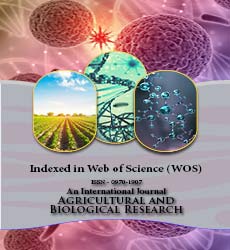Agricultural and Biological Research
RNI # 24/103/2012-R1
Alok Bharadwaj
Soil is the fertile and uppermost layer of the earth crust. To meet the requirements of increasing population, farmers used chemical fertilizers and insecticides to increase the crop yield. As a result of which the soil become saline or usar. So, here in this paper an effort has been made to treat such problem soil with certain amendments such as farmyard manure (FYM) and prepared compost and make a comparative analysis by improving the physicochemical and microbiological status of the problem soil. Quantitative analysis of soil microfungi was performed under various combinations of amendments (5%, 10%, 15%, 20% and 25%) with both farm yard manure and prepared compost was recorded in terms of IVI (individual value index). In the present study both these (fym and prepared compost) were taken in the ratio of 5%, 10%, 15%, 20% and 25% (w/w) separately and mixed with the powered soil samples. Physicochemical and microbiological status
of the control soil and various amendments was performed. The results clearly indicates that the values of water holding capacity, organic matter, total nitrogen, organic carbon, cation exchange capacity and exchangeable potassium amplified in both the farmyard manure and prepared compost. On the basis of results obtained of this comparative analysis it can be confirmed that various doses of prepared compost demonstrated improved reclamation of saline-alkali soil over the farm yard manure (FYM). The results of microbial population dynamics clearly depicted that prepared compost indicated improvement in all the three types of microflora i.e bacterial, fungal and actinomycetes population over the control in comparison to farm yard manure (FYM). The improvement in the population of bacterial, fungal and actinomycetes is an indicative of improvement in soil reclamation and management of problem soil.
